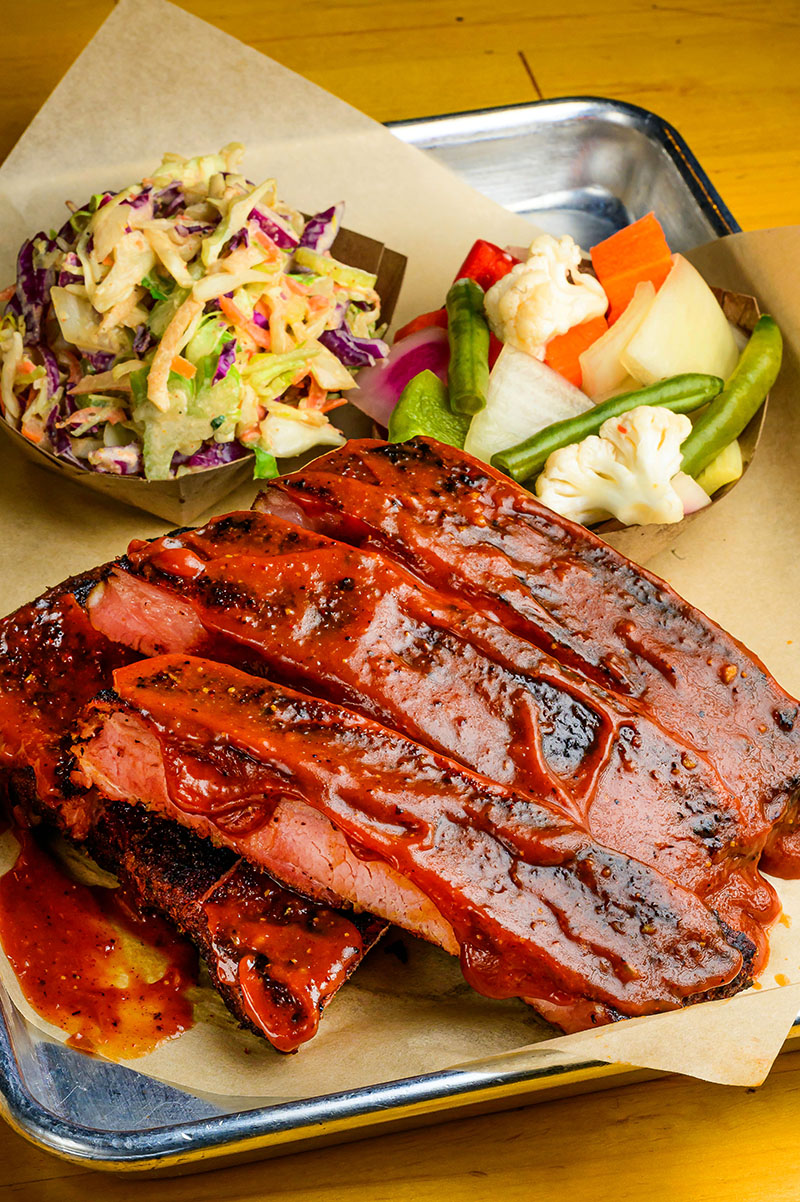Trade your baby back ribs for St. Louis-style this summer.
While many home cooks may prefer the tenderness and ease of baby back pork ribs, Ed Ferencik Sr., co-owner of Butcher’s Kitchen Char-B-Que in South Reno, says St. Louis-style spareribs are worth the time and effort.
“They’re meatier, and there’s more connective tissue for a long, slow-smoking cook to break down,” Ferencik says. “And they are more juicy and tender than baby back ribs.”
Ferencik, whose experience with meat and butchering spans more than 20 years, translates the restaurant’s rib recipe for the home cook. He starts with the criteria for a good rack of ribs, then walks through meat selection, smoking, braising, and finishing.
“A real good rib should have a good tug on it; it should have a nice crust,” he says. “You don’t want the bone to come out, at least not for a rib aficionado.”
Pick and Prep
Start with a St. Louis-style rack.
“If you can buy the whole side of pork, that’s the best value,” Ferencik says.
If the rib tip comes with your rack, cut it off on the fat line so that the rack is an even rectangle. Flip the spareribs over and remove the bottom membrane. Ferencik uses a hook to grab the membrane and a towel to add friction to his fingers as he pulls it off (doing it without a towel is a lesson in frustration). Coat both sides of the rack (and rib tips) in a dry rub.
“The salt can pull a lot of moisture from the rib if you go too long, such as overnight, so plan to add the rub four hours before you cook,” Ferencik says.
Smoke, Braise, and Char
From here, smoke the ribs on indirect heat, placing the ribs in the center or side of the grill away from the charcoal or flame. Fill several foil packets with wood chips and poke holes in the packets. Toss them on the charcoal or propane grill one at a time, replacing them every hour to create consistent smoke.
Smoke the ribs for three hours at a low temperature, close to 220 degrees F. Then, put the ribs on foil, pour half a cup of apple juice over them, and close the foil pouch, pinching it closed at the top. Braise the ribs for 1½ hours, making them tender. This step also can be done in the oven.
Finally, char the ribs on direct heat for five minutes per side. After flipping, you can add barbecue sauce to the top meaty side, but most restaurants let people add sauce at the table. Don’t char the sauce side; the sugar in the sauce will burn quickly, turning the ribs black and hard.
Ferencik says to use a temperature probe to ensure the ribs reach 190 degrees F before removing them from the heat. Once off the grill, they should continue cooking a little more while resting.
“To me, 195 degrees finished is perfect,” he says. “You get over 200 degrees, and it’s shredded. Now it’s pulled pork.”
Ed Ferencik’s Rib Rub
(courtesy of Butcher’s Kitchen Char-B-Que in South Reno. Makes enough rub for 2 racks of ribs)
6 tablespoons kosher salt
2 tablespoons dark brown sugar
2 tablespoons paprika
1 tablespoon dried oregano
1 tablespoon ground black pepper
2 tablespoons curry powder
2 teaspoons garlic powder
1 teaspoon onion powder
1 teaspoon dried thyme
1 teaspoon dried marjoram
1 teaspoon dried parsley
1 teaspoon ground cumin
1 teaspoon dry mustard powder
1 teaspoon celery seeds
½ teaspoon cayenne
½ teaspoon ground fennel seeds
¼ teaspoon ground white pepper
Combine all spices in a bowl. Place rib racks on large cutting board. Pour dry rub on both sides and massage with your hands. Lightly cover ribs and let sit to absorb flavor for up to 4 hours, but not more, before cooking.


